
Patent Victory Seen as a Win for Photo Industry

A recent decision by the U.S. Federal Circuit Court of Appeals is being hailed as a big win for the photo industry. The 2-year battle revolves around a company’s attempt to enforce a software patent, contending it owned exclusive rights to a data processing system for grouping photographs together.
The Kim & Lahey Law Firm represented the plaintiff, ImageQuix, a software company that was based in Greenville, SC, until recently moving to Raleigh, NC. ImageQuix is a pioneer in the online photo sales industry and has serviced professional photographers for more than 20 years.
In fall of 2018, Snapizzi, a Washington state corporation, began contacting ImageQuix about its patented image tagging technology (U.S. Patent 8,794,506). ImageQuix had just released Blueprint, their latest photography workflow software that also includes image tagging to sort and organize large volumes of images.
Snapizzi insisted they purchase a license in order to continue offering image tagging. In reviewing the patent with its counsel, Doug Kim, ImageQuix President Alex Kovacevic decided to take the dispute head on. ImageQuix filed a lawsuit asking to the court to hold that Snapizzi’s patent was invalid and not infringed. ImageQuix stated that photo tagging technology was not new to the industry and that the Snapizzi patent was invalid. Snapizzi snapped back with a counterclaim alleging patent infringement.
In December of 2019, the District court ruled the Patent was invalid under the now famous United States Supreme Court 2014 ruling Alice Corp. v. CLS Bank. Alice held that a computer implemented electronic escrow service was an “abstract idea” and therefore ineligible for patent protection under 35 USC § 101. In response, Snapizzi appealed to the Federal Court that hears all patent appeals. Last week, the Federal Circuit affirmed the District Court holding that the Snapizzi patent was invalid.
Rich Scanlon, CEO, ImageQuix, says, “It’s never an easy decision to take on the burden of a long court proceeding, but we felt it was our duty as industry leaders to go on the offensive. This ruling is also vindication for the school photo industry as a whole. We fought back against those who would try to take credit for, and advantage of, the collective innovations our entire industry has invested immense resources in. We can, and should, all share in this victory.”
“We could not stand by and allow innovation to be challenged and stifled. I am proud to be a part of a company that cares and always does the right thing,” says Tim McCain, CRO of ImageQuix and Founder of PhotoLynx.
“From the beginning, we believed that the Snapizzi patent was invalid and that its claims were in violation of the Alice ruling. We’re happy that both the District Court and the Federal Circuit Court of Appeals agreed with us,” says Doug Kim.
Although the Alice opinion did not specify that all software is patent ineligible, the case is widely considered as a decision against software patents or patents on software for business methods. Patent eligibility rules are supposed to keep patents from being issued that cover ineligible subject matter, which the U.S. Supreme Court determined in its Alice decision constitutes the “basic tools of scientific and technological work” so as not to impede innovation and undermine patent laws.
“While Alice introduced hurdles to patenting software, understanding these rules and rulings allows a patent to be written to minimize the risk and even avoid § 101 rejections,” said Doug Kim, a former software programmer and now patent attorney.

